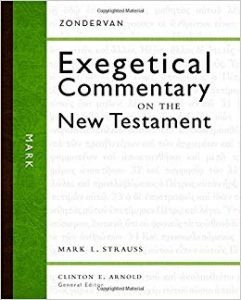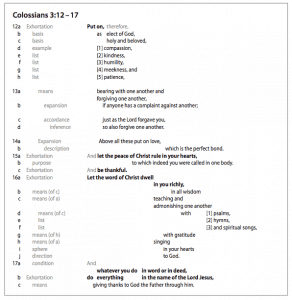The Graphic Layout feature in Zondervan’s Exegetical Commentary volumes is a unique and helpful visual tool that organizes Scripture in a way that will aid pastors and professors in their preaching and teaching ministries. The Graphic Layout feature offers readers a fresh perspective on the biblical text, which aids exegesis and lays a foundation for interpretation and application. There is nothing like the Graphic Layout feature in English-language bible commentaries.

Many of the best biblical scholars today are contributing to this well-reviewed commentary series. Clinton E. Arnold, Dean of Talbot School of Theology, is the General Editor of New Testament volumes, as well as author of the Ephesians commentary. Daniel I. Block, Professor Emeritus of Old Testament at Wheaton College, is the General Editor of Old Testament volumes, as well as the author of the Ruth commentary. Associate editors include George Guthrie, who is well-known for the Hebrews commentary in the NIVAC series, and Thomas Schreiner, who is well-known for his 1-2 Peter commentary in the NAC series.
Theological Perspective
Theologically, the ZECOT/ZECNT series is broadly evangelical. Scholars from diverse evangelical traditions have contributed volumes, like Arminian scholar Grant Osborne who wrote the Matthew commentary and Reformed scholar Frank Theilman who wrote the Romans commentary.
All authors share the conviction that the bible is the inspired Word of God as well as other fundamental truths such as the sinfulness of humanity, the incarnation and deity of Jesus Christ, the Trinity, the death and resurrection of Christ, the indwelling of the Holy Spirit, and the return of Christ.
Authors also come from different vocations. They may be professors like Schreiner, pastors like Mickey Klink (more below), or missionaries like Gary Shogren (more below).
Seven Features
In ZECOT/ZECNT commentaries, every biblical passage is divided into seven components: (1) The Literary Context: In this section, the author discusses the passage in light of what comes before and after it in the text. (2) Main Idea: Here, the passage is synthesized into two to three sentences, which preachers should find especially helpful. (3) The Translation and Graphic Layout: More below. (4) Structure: Next, the author describes the “flow of thought” that leads to interpretation. (5) Exegetical Outline: Here, the overall structure of the passage is displayed in outline form. (6) Explanation of the Text: In this section, the author discusses the meaning of the text, which includes discussion on the original languages, though the explanations are not overly technical. (7) Theology in Application: This is another component preachers will find helpful because it offers suggestions on how to apply the passage today.
Understanding the Graphic Layout in Zondervan’s Exegetical Commentaries

According to Arnold, the ultimate objective of the Graphic Layout is to enable the reader to comprehend the meaning of the biblical text:
Another unique feature of this series is the presentation of each commentator’s translation of the Greek text in the graphical layout. The purpose of the diagram is to help the reader visualize, and thus better understand, the flow of thought within the text. The translation itself reflects the interpretive decisions made by each commentator in the ‘Explanation’ section of the commentary. [1]
65% of people are visual learners. [2] Examples of visual learning methods include maps, charts, and diagrams. Yet, according to Cornerstone University, though most people have one dominant learning style, multiple approaches to instruction often assist the average person. [3] If this is true, the Graphic Layout feature will help visual learners the most, but it will help all readers to some degree.
The Graphic Layout feature is more than just a creative display for stylistic purposes. The feature visually organizes words and phrases in the English-language biblical text, yet, as Guthrie explains in the video below, “the diagram reflects the different grammatical dynamics in the Greek text.” More than just spatially arranging the verse components, the layout communicates information to the reader that aids exegesis.
In this six-minute video, Guthrie explains the purpose of the Graphic Layout and how to read it:
Please go to George Guthrie’s YouTube channel if you are interested in seeing other videos in this series.
Pastors Will Find Help
The space that volumes devote to the original languages of Scripture won’t overwhelm pastors or other readers who don’t have familiarity with Hebrew and Greek. Authors concentrate on explaining the meaning of the text. Volumes are also not focused on providing a history of interpretation on each passage either, “but to exegete each passage of Scripture succinctly in its grammatical and historical context.” [1]
I share in preaching responsibilities at my church. Commentaries in the ZEC series have become a go-to resource for me because I find so much information in one place and the layout is accessible. I like that I have access to the Greek text, yet the authors don’t overwhelm me with technical information.
The Graphic Layout Feature in particular gives me a fresh angle on familiar texts and has proven to be helpful when I’m creating a sermon outline, because the author’s thinking is visually organized for me. The section summaries, and background information such as authorship and setting are basic, but I don’t often require more than that when it comes to preaching. The applications sections at the end of each passage often prove to be an excellent starting point as I think through applying the text.
The Affordability of Zondervan’s Exegetical Commentaries
Sometimes well-reviewed commentaries are so expensive that many pastors and professors cannot afford them. This is not the case with ZECOT/ZECNT volumes. For example, the volume for each Gospel is about $30-$40 at the time of this writing. Some of the smaller biblical books, like Galatians, James, and Ruth, retail for about $20-$25 at the time of this writing. Electronic editions of these volumes are less expensive, sometimes even half the price of hardbacks. There are currently no paperback editions in this series.
Build the foundation
There are many reasons to utilize ZECOT/ZECNT commentaries, yet the most unique component is the Graphic Layout feature. The diagrams are a helpful visual tool that will help readers understand the biblical text and build an exegetical foundation upon which interpretation and application can be made.
Footnotes:
- The quotations in this article from Clint E. Arnold comes from the “Series Introduction,” which is included at the beginning of each volume in the commentary series (p. 7-10, sometimes p. 8-11, or p. 9-12)
- https://papers.ssrn.com/sol3/papers.cfm?abstract_id=587201 (accessed 2/21/19)
- https://www.cornerstone.edu/blogs/lifelong-learning-matters/post/your-guide-to-understanding-and-adapting-to-different-learning-styles (accessed 2/21/19)
